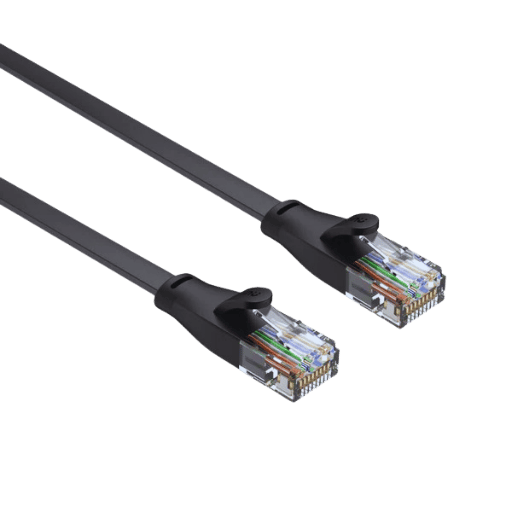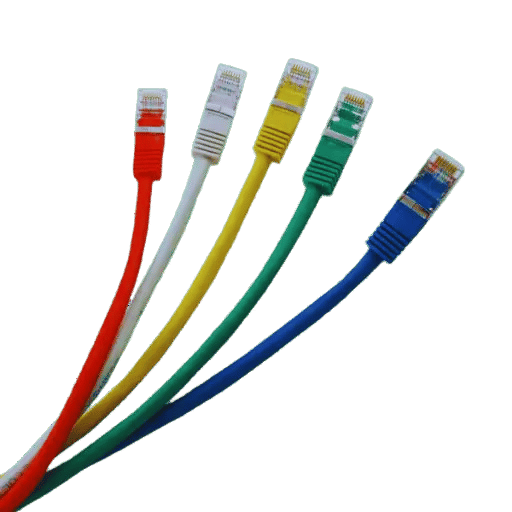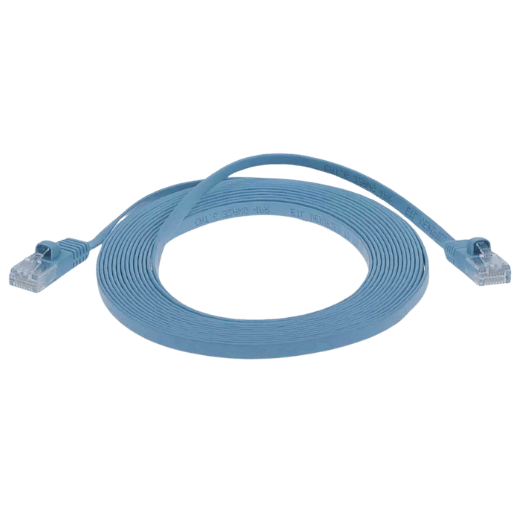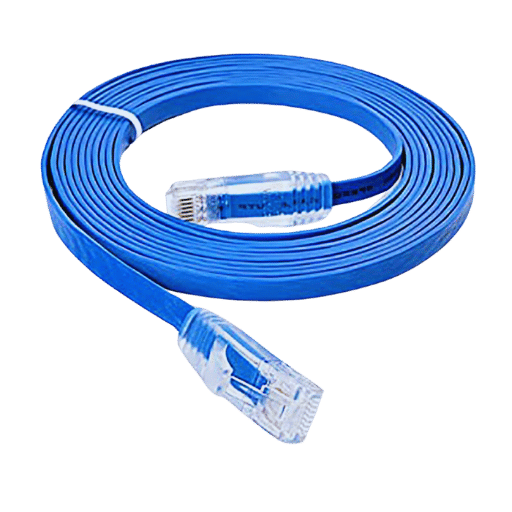As time has progressed, our lives have revolved around technology, which is why an uninterrupted network connection is of utmost significance. Flat Cat6 ethernet cables seem to be an inexpensive method of providing high network speeds while different from traditional round cables. The focus of the article would be to highlight the salient features of flat Cat 6 cables, which include the ability to use less space and ease of installation, making them suitable for the design of future homes and offices. Further, by analyzing the technical details and advantages of such cables, we can show how they manage to increase the speed and rate of data transfer, which enhances the network as a whole. This provides a brief overview of the post’s main idea, which is that people should expect to learn new opportunities to improve Ethernet performance and networks as a whole.

Flat Cat6 Ethernet cables set themselves apart with their unique structure and design characteristics, including the use of gold-plated RJ45 connectors. Their superior light and thin construction enables them to be effortlessly placed in carpets, between tight areas and walls making it easier for them to fit into the desired spaces than round cables. Furthermore, since these cables have less probability of getting tangled, they can be conveniently handled, thus making them suitable for home and office usage, which tend to have a lot of wiring complexity. In terms of frequency, a frequency range as high as 250 MHz and a transmission rate of 10 GB per second enables them to carry out functions over short distances, thus serving a purpose for high-intensity tasks. Moreover, these wires have been designed in such a way that minimal cross-talk and EM interference occurs, thus allowing for a strong and consistent network.
As seen on the web, Cat6 Ethernet cables have benefits, unlike any previous generation cables such as the Cat5e. For starters, these cables have a high bandwidth ability that reaches 250 MHz. This is ideal for heavy and large network applications. These cables can also operate at high speeds with data rates of up to 10 Gbps but over short runs (55 meters or 180 feet), which is sufficient for both the gigabit ethernet and the new 10-Gigabit ethernet networks. Also, because Cat6 cables have been subjected to more severe requirements for crosstalk controls, such as thicker copper wire and better wire shielding, these cables are expected to have lower CAT6 cable losses. These cables have also been constructed with tighter twist ratios and better housing, which help maintain signal integrity and reduce delay skew in structured cabling systems, particularly in Cat6 UTP configurations. This allows Cat6 cables to be useful in both commercial and residential quarters, allowing for good data transfers.
A flat Ethernet cable improves over conventional round cables for several reasons. First, their slim and precise profile makes it simple to run under carpets, through baseboards, or in small spaces, hence lessening disorder while enhancing the look in both homes and workplaces. Furthermore, flat cables are often double-shielded and have fewer twists, which helps to reduce cross-talk and electromagnetic interference, leading to enhanced network performance. Moreover, flat cables are more flexible, making installing them easier since they can be placed in tight spaces or used at angles without having the chance of twisting, which maintains good data transfer efficiency.
The RJ45 connector is essential for data communications in Ethernet networks as it provides a standardized interface for connecting routers, switches, computers, and other network devices to Ethernet cables. These connectors allow for a proper electrical connection through eight pins connected to the wires in the Ethernet cable, ensuring a secure connection for seamless data transmission. These connectors are satisfactory in terms of maintenance measures because they ensure that the signal is not downtrodden and there are minimal amounts, even losses so that the maximum speed and reliability of the network suffices. The sufficient designs allow for precise pin configurations which are housed in solid materials which reduce the interference of the signals and are durable for both home and business use.

One of the most popular questions that is discussed is the performance differences between Cat6 and Cat5e cables, it should be noted, however, that both offer a reasonably good networking alternative but that the Cat6 cables are preferred in most instances due to their performance advantages A good portion of the sporting performance from the crosstalk and cat cables is adequate Bandwidths of up to 250 MHz and aids in supporting a maximum distance of around 10 Gbps relative to 55 meters. More demanding applications may include data centers and enterprise networks that place higher demands on cable stranding and transmission performance. In comparison, a Cat 5e cable would typically attain a maximum bandwidth of around 100 MHz and a maximum speed of 1 Gbps. Incorporating tighter twists and other crosstalk features in the Cat6 Cables significantly reduces noise and provides more robust signals. Hence, in cases where enhancements on existing networks are emphasized or future-proofing of the network is essential, Cat6 is most times preferable.
While the siding between Shielded Twisted Pair STP or Unshielded Twisted Pair UTP is offered in Cat 6 cables, I weigh some essential considerations. Powered Cat6 cables do succeed in significantly minimizing the effect of crosstalk, and other forms of electromagnetic interference STPs do not eliminate them. This makes them useful in environments with many wires in an enclosed space or where electrical noise is prominent. Thus, they are commonly found in industrial applications or data centers. On the other hand, unshielded cables do not have a high level of protection but are more comfortable to work with and install. This makes them the preferred option for an average domestic or corporate network where there are Adamant restrictions on the electricity in areas using CCA cables. In the end, I make my choice considering the trade-off between the extent to which the environment is likely to interfere and the degree of flexibility plus the cost that unshielded cables bring, ensuring I select the most applicable option for the scope of the network and its budget specifics.
As with all telecommunication parameters, the practical and the functional need to be reconciled to determine the length of an Ethernet patch cable; ethernet cables are commonly believed to be designed for optimal performance when operating under a range of not more than 100 meters (uniformly 328 ft) for standard applications. However, with still increased length comes an increase in latency and degradation of the signal; thus, repeaters or switches would be needed. Longevity is also imperative, with more robust cables having wider jackets like PVC or LSZH (low smoke zero halogen) that can withstand such variability. These collars, in addition, also insulate the wiring from harsh conditions such as wires getting cut off, extreme temperatures, and exposure to chemicals. To define a threshold on the cable length and its durability, one must determine the operational requirements concerning the environment and budget for the given application.

It is reasonable to emphasize the maintenance of appropriate network cable orientation to keep a network configuration organized. First, the framework of the cable paths should be designed to avoid as much conflict as possible and to prevent cable coiling. Cables can be bundled together using cable ties or fabric Velcro, provided that they are not exposed to excessive tension that may cause harm to the structure. It is advisable to place cables in a cable tray or duct so that they are tidy and less prone to physical obstructions, which could become risks of trips. Using labels or color codes on cables will be helpful when troubleshooting circuits. Cables should be kept evenly balanced so that they are not tight or loose to maintain their operating performance and make adjustments in the future more convenient.
Firstly, it is essential to check whether the flat Cat6 Ethernet patch cables and the patch panels comply with the Telecommunication standards TIA/EIA-568. The Cat6 patch panel should be installed first to validate its proficiency. Selecting up to four RJ45 connectors and patch panels with a bandwidth of 6 about 250 MHz is essential. With the same equipment, matching and signal degradation due to different components is avoided. In this way, the network efficiency is maintained. Furthermore, cables are connected, and a general check-up should be maintained with the help of a cable tester to guarantee that transmission defects do not occur, hence adhering to the set standards.
When fastening Snagless cables, it is best practice to select connectors installed with molded boots since they protect the insertions and removals (in this case, the RJ45 connectors that are gold plated with a thickness of 50 microns). Also, make sure you do not order cables that are longer than required to have slack, which decreases the chances of tangles and improves the system’s reliability. To avoid mechanical strain on the cable and blockage on the network routes, it is recommended that loop organizers be used and the cables arranged properly. At the risk of performance loss, ensure that the network elements are compatible and comply with the standard specifications, along with the advancements in the networking technology field. Regular assessments and maintenance checks will further ensure the durability and efficiency of the snagless installation.

On the other hand, to take advantage of the Gigabit technology the most en_US, Cat6 Ethernet cables are the right option because of their substantial upgrade over the other categories in terms of design and capacity to deal with high transfer rates. With the assistance of Cat6 over an approximate span of 100 meters, transmission rates of up to 1 Gpbs can be attained. They have been specifying more stringent parameters for crosstalk and system noise and have added shielding and twisted pairs, which enhance performance and reduce interference. This enhances the quality of the links as well as the data being handled, which is critical for organizations and conditions that require high-performance networks. Cat 6 cables, on the other hand, are also compatible with the previous standards, which makes it easier for them to be deployed in several network designs without compromising data or network performance.
Bare copper wire is, amongst other materials, considered ideal for signal transmission performance in network systems because of its high conductivity and low resistance. The performance of bare copper wire is far better than that of copper-clad aluminum wires owing to features like lower attenuation and thermal sensitivity. The cross-sectional area of bare copper also provides consistent impedance to lines and bulk cables, resulting in lower transmission line reflection and additional EMI due to cables, producing cleaner signals critical for most high-speed data systems. Among other things, such high-speed transmission of data integrity is highly effective with the installation of bare copper wires within the network. In addition, bare copper wire also contributes greatly to the overall lifetime of the network installation, thus enabling strong and reliable connections.
Powering devices over the Ethernet has now made it more convenient to integrate cameras, VoIP phones, devices, and peripheral equipment into the network. Most devices today require communications and power, and Ethernet cabling provides a cheaper, more straightforward, and cost-effective means. The use of Cat6 cables for PoE has higher data transfer rates and power transfer capacity, which are helpful for a wider span of devices, including IP cameras, VoIP phones, and wireless access points. Cat6 cables have enhanced structural and performance specifications thus supporting their use in applications where shielding is required, Cat6 cabling has superior construction that guarantees less interference and higher confidence of providing power and data over long distances.

The term of applicability ‘low cost’ is being overused for cables like twisted pairs or, more accurately, flat cat6 cables. By design, they are suitable for deployment where the requirements are not too demanding. In terms of application, it would be ideal for use under a carpet. However, relatively weak crack retention and seam strength may cause problems during installation and incorporation of organic solvents and end up delaminating flat cables, which undermines their impact resistance. Thus, this leads to the formulation of the premise that to reduce damage to the cable, a guard should be employed, and caution should be exercised during the installation of the cables.
To provide for the compliant installation of offices, it is essential to observe industry standards and the manufacturer’s recommendations when deploying flat Cat6 cables underneath carpets. This also ensures that a cable’s characteristics correspond to its installation’s environment and purpose. Using cable guards or conduits will help prevent the wires from being in foot traffic while complying with safety norms. Periodic inspections and maintenance of the cabling infrastructure can also address potential problems in advance for both safety and efficiency when working in a professional environment. It helps to plan the path of the cables so that they do not lie in areas of high traffic, increasing compliance and the durability of the cable’s properties.
When looking for alternatives for hiding network cables, many options allow for the concealment of wires while still keeping the workplace tidy and protecting the cables in question. One option is using cable trays or raceways, which organize cables and run them along the walls or even the ceilings; this is a good option as it also addresses aesthetic needs while enhancing safety by reducing tripping. Another alternative is using plenum-rated cables, which can be installed in air handling spaces so they can be concealed and installed without compromising fire safety measures. Wireless technology can also be an alternative, this decreases the amount of cables physically installed around but still allows for networks to be interconnected, except for some topologies that require patch cords, although, using wireless technology encourages flexibility within the space.

A: The first striking benefit of the flat ethernet cable over the regular round interconnects is flexibility, which makes it easier to install. A round ethernet cable will stiffen the path where it routes, whereas a flat ethernet cable has a good propensity for bending along walls and routing under floors well. High-performance flat Cat6 cables excel in providing high data rates, which entirely alter their bandwidth to as high as 10 Gb/s, accommodating a data-rich ecosystem with never-before obstacles. Also, because of their structural make, flat cables tend to tangle less, which improves cable management.
A: Cat6 flat patch cables are just a more efficient form of the standard Cat6 cable. They are much sleeker and thinner but have the same performance of 10 Gb/s. Their volume profile also allows them to fit into tight areas easily. Both cable sets utilize fully copper conductive wires with RJ45 heads with gold plating to enhance connectivity. The only considerable difference will be the shape, with flat cables being more bendy and easier to hide while the other remains bulky.
A: Indeed, Cat6 pour cables, Cat6 keystone jacks, and other Cat6 network components utilize the same standard. They simply have standard RJ 45 connectors, just like Cat6 cables, ensuring smooth inclusion into existing communication networks without any infrastructural alteration. This also enables the easy replacement of infrastructural elements with new ones, such as in cases of expansion or upgrading of the network.
A: Yes, flat Cat6 Ethernet cords are sold in bulk with holes made for the varying tasks they are to be utilized for, but some of the stock’s most common lengths include 3ft, 5ft, 10ft, 25ft, and 50ft. Other suppliers, such as Tripp Lite, have been known to provide their series of Cat6 Gigabit Snagless Molded Flat cables within these dimensions and other specific measurements. So, for example, if more or less than the standard is required, those suppliers will assist in getting the cable with the desired length.
A: Without a doubt. Flat Cat6 cables can easily be used in home and professional network setups, as they are very adaptable. They can be effectively used for the home to connect smart televisions, gaming consoles or home office equipment. In professional settings, these cables are designed for data centers, server rooms, and office networks, which require more space and organized cables. They can handle demanding network use in both environments due to their high-speed capabilities.
A: Tripp Lite Series Cat6 Gigabit Snagless Molded Flat Cables, and similar types, have a unique boot design to flat Ethernet cables. It protects the locking tab of the RJ45 connector, making it difficult for the tab to snap during installation and removal and get caught with other cables and other objects, resulting in as much damage as can occur while managing the cable. Snagless flat wires are made in a way that regular flat cables don’t, and that’s why such cables remain vulnerable to damage even while being used.
A: Many flat Cat6 cables of recognized companies like Panduit are RoHS compliant. According to this, these products, including patch cables, are produced without the use of specific hazardous compounds under the RoHS directive, such as lead, mercury, and cadmium, thereby leading to ecosystem conservation. Appealing to manufacturers is not enough; to get safe and environmentally friendly products, look for the RoHS-compliant sticker when buying cables.
A: Certain Cat 6 cables are designed strictly for indoor purposes; however, some do exist and are rated for outdoor use. These cables, in particular, are built to endure high moisture, temperature changes, and UV exposure. Always select quality outdoor-rated cables if running cables outdoors to ensure performance and durability against the external environment.